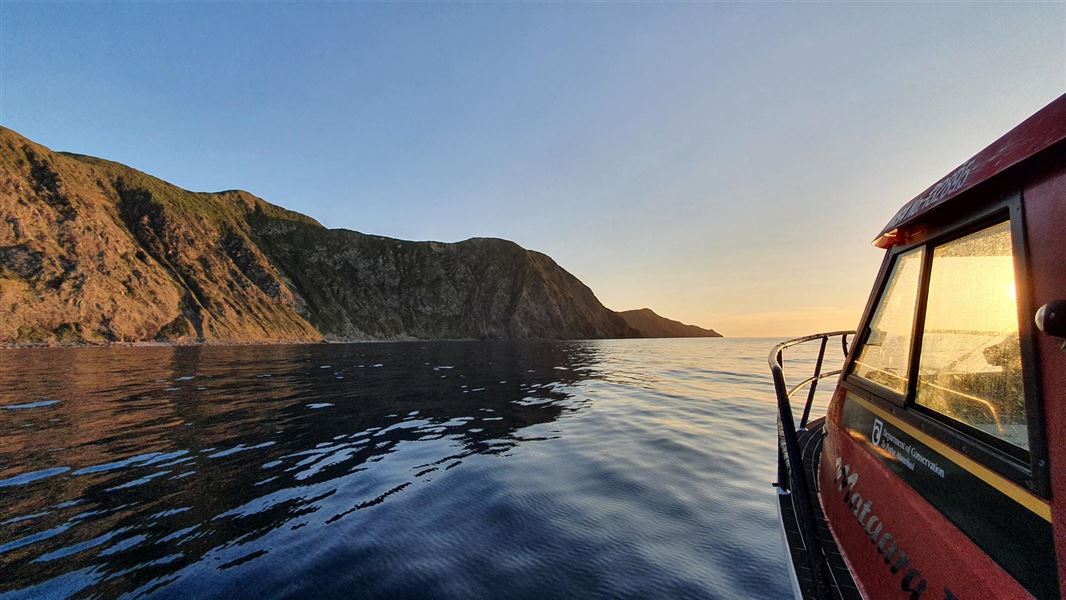The marine reserve was established in 1992 and is 2167 hectares.
Access to the reserve
Kapiti Marine Reserve is 30 km from Wellington city and is located between Paraparaumu and Waikanae beaches and Kapiti Island.
Drive north on SH1 and turn on to Kapiti Rd in Paraparaumu.
The marine reserve touches the mainland at the Waikanae River mouth. Foot access to the reserve is from Waikanae Beach or Paraparaumu Beach on either side of the Waikanae Estuary and river mouth. There are walking tracks through Waikanae Estuary.
Launching boats
Launching of boats is only allowed at Waikanae Boating Club and Kapiti Boating Club. Be aware that this is a beach launch and can be tricky. 4WD vehicles are necessary.
We recommend you seek local advice if you are not from the area.
Marine Reserve protected areas
Kapiti Marine Reserve is made up of two separate protected areas – the western and eastern reserves. Be aware that the eastern marine reserve boundary extends between Kapiti island Paraparaumu and that fishing within the Marine Reserve is not permitted.
View maps and boundaries of Kapiti Marine Reserve
Permits
If you would like to visit Kapiti Island or wish to snorkel from its shores, you need to travel to the island. You must have a permit.
Visit Kapiti Island Nature Tours for more information.
Marine mammals
Marine mammals may be present within the reserve- find out more about sharing our coasts with marine mammals.
Drones may require authorisation
Drones can:
- disturb, injure or kill native birds
- disturb marine mammals
- disturb other visitors.
An authorisation is required from DOC to use drones near marine mammals for any reason, including private use. Find more information and apply for authorisation.
Water safety
Kapiti Island and its surrounding waters are known for changeable weather – sea conditions can quickly become treacherous.
Kapiti Marine Reserve connects Kapiti Island Nature Reserve with the Waikanae Estuary Scientific Reserve. This brings two major sea currents together. The cold southern current and the warm d’Urville current. This results in a unique environment, full of species that are typically only found further south or further north.
Rich habitats and unique reefs
Under the waves around Kapiti Island are a huge variety of sea-beds. These include soft sediments with burrowing crabs and sea cucumbers, and beds of seaweed providing habitat for fish and kōura (rock lobster).
There are also stretches of sea anemones that snapper feed on. And deep rocky reefs encrusted with sponges. Rare rhodolith beds (or ‘ocean tumbleweeds’) are also found here, which provide for a huge diversity of wildlife.
You can explore under the waves with LEARNZ virtual field trip.
Little penguins/kororā
Kororā are can be found swimming in the marine reserve. Please keep an eye out when accessing the reserve as meeting people, roads, and dogs can threaten their survival.
You might see them at the reserve when they’re ashore between May and June or November and March. Remember to give them plenty of space as they’re easily disturbed. If you want to see them up close, check out the Kapiti Kororā Cam.
Guardians of Kapiti Marine Reserve trust
The Guardians of Kapiti Marine Reserve trust (GoKMR) is a registered charitable trust (CC54807) that provide the local community with an opportunity to discuss their concerns regarding the management of Kapiti marine reserve.
The trust’s purpose is to advance and promote the conservation and protection of the Kapiti Marine Reserve and surrounding marine environment for the benefit of the local community now and for future generations.
Read more about Kapiti Island nature and conservation
Report illegal or suspicious activity
Don't take, disturb, kill or damage anything within the reserve - it's illegal. If you see people taking anything from the reserve, report the activity as soon as possible.
You can call 0800 4 POACHER (0800 476 224) or 0800 DOCHOT (0800 362 468).
It is also an offence to pollute or litter the reserve, discharge any firearm in or into the reserve or erect any structure in the reserve.
Reporting pests
Find-A-Pest lets you report potential pest species, including marine, plant, animal and fungal species.
If you come across something out of the ordinary, upload a picture to the app and a specialist will help identify it. If it's a biosecurity threat, this will be forwarded to Biosecurity New Zealand. If possible, take photos and record the location and name of the vessel.
Or call the Ministry for Primary Industries' Pest and Diseases hotline on 0800 80 99 66.
Find out about the Māori history of the waters between Kapiti Island and the mainland.
Protect our marine reserves
- No fishing of any kind.
- Don't take or kill marine life.
- Don't remove or disturb any marine life or materials.
- Don't feed fish - it disturbs their natural behaviour.
- Take care when anchoring to avoid damaging the sea floor.
Wellington/Kapiti information
| Phone: | +64 3 546 9339 |
| Email: | nelsonvc@doc.govt.nz |
| About: | Whakatū/Nelson Visitor Centre provides visitor information for this area |
